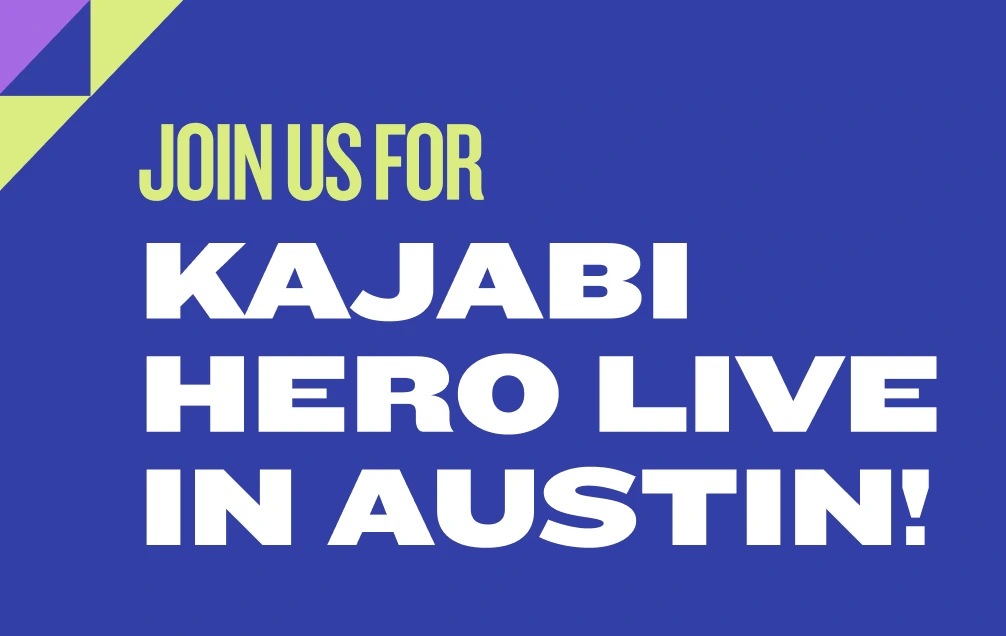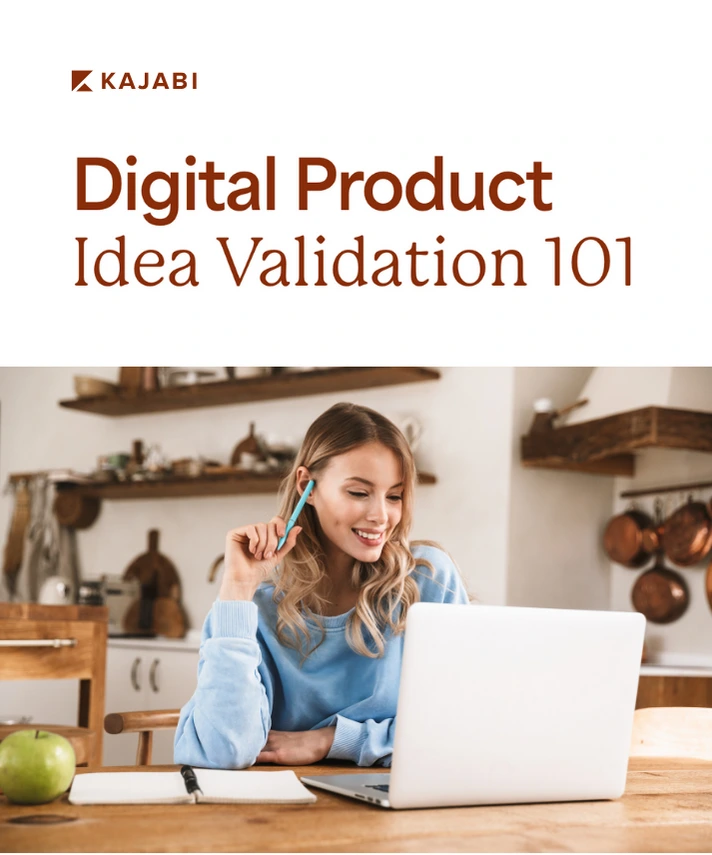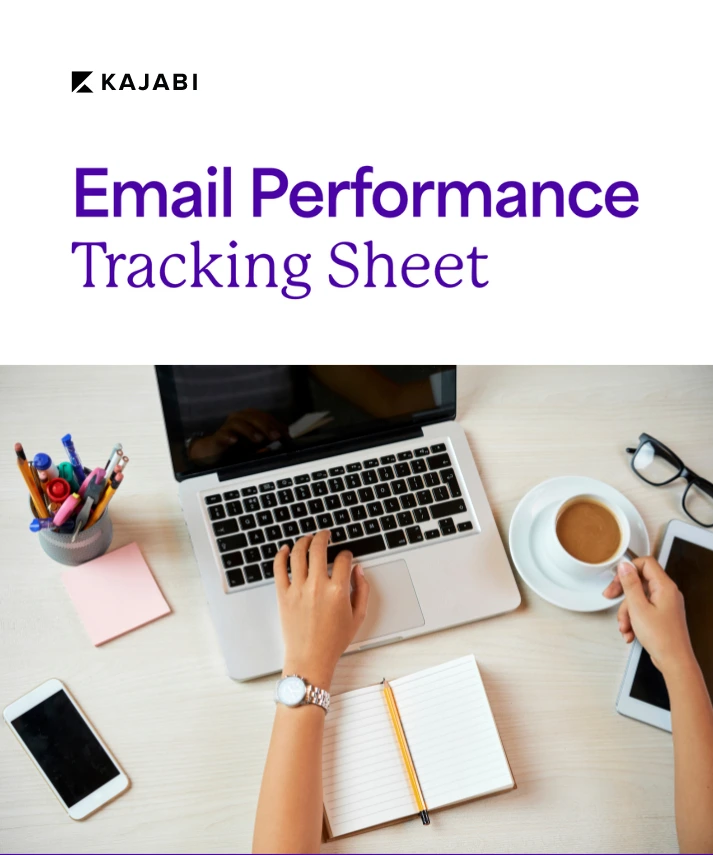
17 digital products you can sell online
Get free expert insights and tips to grow your knowledge business sent right to your inbox.
People ask us one question over and over: What is a digital product? And why should an entrepreneur focus on digital products instead of just their physical counterparts?
We live in an increasingly diverse marketplace. People are earning money from a variety of endeavors, whether they hang out a shingle online or start a brick-and-mortar business.
Maybe we’re biased given our industry, but we believe that digital products offer the easiest and least expensive point of entry for any aspiring entrepreneur. Our Knowledge Commerce customers — entrepreneurs who earn great money teaching what they know — prove our hypothesis.
Today, we’re going to guide you through the process of understanding digital products and figuring out what you might want to sell. Even if you’re already part of the digital economy, you might discover a new revenue stream to add to your burgeoning business.
We’ll start by defining a few terms, then we’ll get into our 17 suggestions for the most profitable digital products to sell online.
What Is a Product?
A product is any item that you can sell to someone else in exchange for cash or barter. It could be a piece of produce, an electronic gadget, or a comfy couch.
Until the Internet altered commerce for the better, a product was always a physical object or item — something to distinguish it from a service. It was something you could pick up, see, smell, hear, or even taste.
That’s changed now that many entrepreneurs start businesses online. The virtual world has opened up a new category of products (which will get into later).
The point, however, is that a product is something you sell. Most often, you ask for money in exchange for the product. That’s how you earn a living.
Products differ from services in that there’s no obligation beyond the transaction. The product already exists, so there’s no further work for the seller to perform.
{{product-idea}}
What Is a Digital Product?
A digital product is any product you sell online that doesn’t have a physical form or substance. You can’t hold a website template in your hand, smell an e-book, or taste a software program — Uber eats does come close though ; ).
You can turn digital products into physical products. For instance, many people buy e-books in PDF format, then print them on their computers. The product becomes physical, but it started out in a digital format.
Some online entrepreneurs try to take shortcuts. They create poorly constructed digital products and assume they’ll make a living from them.
More often than not, those entrepreneurs fail. Why? Because customer retention matters more than customer acquisition.
In other words, your goal as an entrepreneur who sells digital products should be to create more products and convince your existing customer base to buy them. That’s how true wealth becomes possible.
Why Are Digital Products Preferable to Physical Products?
You might wonder why you would offer digital products instead of creating your own physical product. After all, physical products dominated commerce for hundreds of thousands of years.
Digital products have many advantages over their physical counterparts, especially for the entrepreneur who sells them.
- Inventory never becomes an issue (either in surplus or deficit).
- You don’t have to find a place to store your products.
- Customers can, in most cases, receive the product immediately upon purchase.
- There aren’t any costs related to materials or assembly.
This isn’t to say that you can slap together any digital product and generate a fortune. The product still needs to offer incredible value if you want your customers to return.
You can funnel the time and money you save on creating digital products into making new products available to your customers. Spend your money and time on marketing and advertising as well as branding.
How Can You Market Digital Products More Effectively?
Marketing digital products aren't much different from marketing physical ones. You have to define your audience, target them with brand-appropriate messages, and keep the lines of communication open.
The main difference is that explaining the need for a digital product sometimes proves more difficult than illustrating the benefits of a physical product.
If you need laundry detergent, for instance, you go to the supermarket or a big box store. You scan the shelves, find your favorite brand, and take the detergent to the checkout counter. That’s something you need if you want to wear clean clothes.
Explaining the need for a mobile app or online course can present more challenges. That’s why Knowledge Commerce professionals must focus on educating their audience — through blog posts, webinars, landing pages, satisfied customer reviews, and other marketing assets.
The Most Profitable Digital Products To Sell Online
Now that we’ve covered some of the definitions and obstacles, let’s jump into the opportunities. After all, you probably want to generate as much cash as possible from your online business, so you’ll want to sell the most profitable digital products.
We’ve identified 17 options, many of which you can create and sell directly from the Kajabi platform.
Resist the urge to try to create them all. It’s tempting, but it will spread you too thin. Start with a single product — one that will resonate with your target audience and provide them with maximum value.
Once you’ve established your flagship product, you can branch out. At some point, you might be able to hire staff members to help handle administrative work while you focus exclusively on the creative process.
Without further ado, let’s look at this list of digital products and explore how they might be able to help you grow your business.
1. Courses
We’re obviously big fans of online courses here at Kajabi. In fact, courses are the primary way by which our Kajabi Heroes generate income.
An online course is just like an in-classroom course except that you teach online via text, video, and audio assets. Your customers learn via distinctive modules based on the name of the course and the material you want to convey.
Customers can take your course in their own time without having to worry about meeting deadlines or stressing themselves out. Plus, you can create courses of different sizes and at different price points.
Some of our customers have created dozens of courses, while others stick to one flagship course. It’s entirely up to you. Plus, down the line, you can create other digital products that complement your courses.
2. eBooks

E-books are growing in popularity month over month. In 2021, eBook revenue reached 1.1 billion dollars in the United States.
You can write an e-book on any topic you like. The best news is that, once you complete the product, you don’t have to do any further work — other than marketing, of course. It allows you to earn passive income over months and years.
As the entrepreneur, you decide on the e-book’s length and content. You can either self-publish it on your Kajabi website or seek a traditional publisher. When it comes time to design the ebook, hire a sought-after web designer or use a template to make it look polished.
If you already have customers who have bought your online courses and other digital products, you can introduce them to your e-book. You have a built-in funnel of potential customers.
Some entrepreneurs also create eBook series. They sell them individually and in bundles, which gives them the opportunity to upsell. You could also cross-sell them with your online courses.
3. Photography
Since millions of people publish content on the web every day, there’s a constant demand for unique photography. Stock photo sites, such as Fotalia and iStockphoto, buy images from creators just like you.
Alternatively, you might want to sell your photographs from your own websites. Many fine art photographers take this route so they don’t have to share their profits with established marketplaces.
A great way to get people excited about your photography is to post your images on sites like Flickr and Instagram. These platforms allow you to retain all rights to your photos, which protects your intellectual property while exposing you to potential customers.
Keep in mind that you can sell photographs in many different ways:
- Digital files only
- Small prints
- Large canvases
- Novelty products (such as mugs and T-shirts) with your images on them
The sky’s the limit if you’re a shutterbug.
4. Music
Major labels no longer control what music makes it into the headphones of your average consumer. Indie musicians can make excellent livings by selling their creations by themselves.
Musician and singer Amanda Palmer, for example, launched what was, at the time, the most successful crowdsourcing campaign in history to fund her next album. Since then, she has relied only on grassroots marketing to sell her band’s music.
You can record your own music, then make it for sale anywhere you wish. The freedom to explore your own musical talent and to retain creative control over your output can be freeing as a creative.
Furthermore, you don’t have to worry about dealing with bureaucratic red tape. Instead, you can focus exclusively on your music.
Since you no longer need to produce a physical product, such as a CD, you can make your music available exclusively as digital files. People can then listen to them on MP3 players, their computers, and other devices.
5. Web Elements
There’s a huge demand for web elements in today’s economy. For instance, many people earn six or seven figures by selling WordPress templates.
Premium web design templates create passive income because you only have to create them once. You might have to update it from time to time because of changes to the content management system (CMS), but that’s far less work than creating a whole new product from scratch.
Additionally, you can create as many web templates as you want. The more you provide, the more customers you can potentially convert.
Other web elements can also prove popular in the marketplace. You might sell thematic elements for a web design, such as navigational buttons, header images, font combination suggestions, social media sharing buttons, and more. If you’re creative and artistic, there’s no limit to what you can create and sell.
6. Research and Data

Conducting one’s own research and data can absorb considerable time. Some people don’t want to expend that energy to gather data in one convenient place.
That’s where you come in. Selling data — such as information about your industry or the results of your own studies — can prove massively popular. People who buy that data can then use it to inform their own businesses.
7. Tutorials and Guides
It’s true that many people post free tutorials and guides online. However, if you can create one that’s longer, more in-depth, and of higher quality, go ahead and sell it as a digital product.
We live in a DIY culture. People want to learn how to do things themselves. They’d rather save their cash than pay somebody else.
Plus, consumers want to learn everything they can about subjects that interest them. Documentaries and similar forms of television remain extremely popular for their educational value.
In terms of format, you can create a tutorial or guide however you wish. Some Knowledge Commerce professionals prefer to create videos, while others are better with text or audio. You decide.
8. Software Programs
If you’re a computer whiz, creating a new piece of software might launch you into the stratosphere in terms of potential revenue. People love software because it inevitably cures a pain point.
From productivity and web insights to designing and drawing, lots of software programs have stood the test of time. They remain popular because their core audiences are loyal fans.
These days, many software programs are sold as subscriptions instead of licenses. In other words, your customers pay a nominal monthly fee to use your software. As long as they pay, they retain access.
In many ways, the subscription model offers better revenue potential than licensing. If you sell licenses, you get paid just once. The customer never has to give you another dime. However, you can decide what payment model makes the most sense for your business and wallet.
{{product-idea}}
9. Recipes
Cookbooks are among the best-selling books of all time. People are always looking for fresh takes on their favorite recipes, and many consumers want to explore cuisine from around the world.
Sure, you can find recipes for free online, but there’s a reason people pay for actual cookbooks. It’s assumed that a paid product offers better quality and higher value.
If you’re a chef — amateur or professional — you could put together a cookbook with your best recipes. Consider grouping them based on a specific theme, such as comfort food or recipes from a specific country or city.
A theme makes the book more marketable and therefore more likely to gain traction in the market.
Of course, cookbooks aren’t the only way to release recipes. You could create an app or subscription service that delivers recipes to subscribers. Think outside the box to create a unique digital product that will get everyone talking.
10. Apps
Speaking of apps, it’s possible that mobile applications have become even more popular than software packages. However, they’re essentially the same thing — just one a different platform.
For instance, people used to play games installed via CD-ROM on their computers. Today, they can play similar games on their phones or tablets via an app.
Some apps involve a small charge, while others are so-called “freemium” releases, which means that you can include in-app purchases for people who want more features, benefits, or information.
You don’t even need technical skills to develop an app. You can hire IT people on a freelance basis to help execute your idea and pay a flat fee. Many entrepreneurs take this route.
There are also software program that make creating a simple app fairly easy. However, if the app doesn’t offer much in the way of features, it will become a hard sell for savvy consumers.
11. Podcasts
Most podcasts are free. Entrepreneurs and creatives use them to promote their brands, products, or services.
However, you can also create a subscription-based podcast that offers more features, in-depth guidance, and more. There are numerous ways to do this.
For instance, you could create a subscription-based podcast for which people pay you directly. It would work just like a traditional membership site except that the content is exclusively audio.
You could also take the freemium route. People can listen for free, but if they pay, they get bonus features, extra audio, and other incentives.
Kajabi offers a podcast tool that makes it easy to sell private podcasts or offer free podcasts for marketing.
12. Printables

As mentioned above, digital products don’t always have to remain virtual. Printables have become a popular commodity for crafters and for people who like to stay organized.
You might create printable agendas, schedules, planners, artwork, scrapbooking assets, or something else entirely. You just need an idea for which someone would be willing to pay.
Just package the printables like you would any other digital product. You deliver the package when the customer pays.
13. Swipe Files
A swipe file is a document that contains valuable assets for a particular goal, hobby, or job. For instance, writers often keep swipe files filled with examples of good copy they might want to emulate in the future.
However, swipe files can contain anything you want. If you’re an artist, you could create a swipe file full of icons and other graphics your customers might use on their websites, marketing assets, or other deliverables.
You could also create a swipe file filled with research, data points, checklists, and more. Crafty professionals might sell swipe files with DIY projects, while parenting experts could sell swipe files with indoor activities for children of various ages.
The possibilities are limitless. The important thing is to make sure the information in your swipe file is truly premium. In other words, it should not be regurgitated content from your blog or contain information people could find freely on the web.
14. Templates and Calculators
Similar to tutorials and guides, templates and calculators have become increasingly popular. People want the easiest way to get from Point A to Point B.
Templates could be for anything from interior design to music composition, while calculators might help people determine the ideal interest rate for a mortgage or the best combinations of investments.
You can get creative with these types of assets, but make sure they offer more than the free examples available on the Internet. Your template or calculator should be so sophisticated that you wouldn’t dare give it away for free.
15. Patterns
If you’re the crafty sort, creating your own patterns for cross-stitching, knitting, crocheting, watercoloring, and more can help you assemble a salable digital product. People are always looking for fresh, new patterns with which to create and decorate their homes.
16. Graphic Arts Bundles
Most people don’t know how to create their own graphics, icons, and other graphic assets. They rely on free or premium products for those needs.
The DIY and commercial market converge in this case. Entrepreneurs like you want to build their own websites, but they need attractive assets with which to populate their designs.
Of course, it’s not all just about web design. A creative might use someone else’s graphic assets to design T-shirts and other consumer products. They don’t know how to create the actual art, but they can arrange a pleasing design for sale.
Companies like DesignCuts offer bundles at a significant discount and from multiple creatives. People can buy lots of premium products at a low rate, which benefits both the consumer and the seller.
You can also sell graphic arts bundles on your own. You might do a mix of different types of graphics or create a bundle for each type. Potential assets could include the following:
- Backgrounds
- Textures
- Clipart
- Woodcuts
- Fonts
- Overlays
- Stencils
- Shapes
The list goes on.
17. Coaching Packages
We mentioned before that the commercial marketplace has changed over the last few years. Products and services aren’t as carefully delineated as they were 20 years ago.
You might have noticed that you can now order clothing, sunglasses, and even razors as a service. You subscribe to the service and you receive your deliveries at set intervals.
However, you can also sell services as a package deal. As part of your Knowledge Commerce business, you could offer coaching packages to supplement your income and to create more intimate relationships with your customers.
For instance, let’s say that you teach people how to be better leaders. You’ve created online courses, e-books, and other digital products, but many of your customers would like one-on-one tutoring.
To respond to that need, you create a coaching package. For $300, you’ll spend 30 minutes on the phone with your customers once a week for one month. Of course, you’d adjust the numbers to your liking.
It’s a digital product because you’re selling it as a bundle. It’s also a service because you’re working with your customers one-on-one.
You don’t have to live near one another. You could set up email, telephone, or Skype consultations with your customers. It’s never been easier to accrue customers from the other side of the world.
How To Start Selling Digital Products Online
Of course, you’re going to have to first create your digital product or products. We’ve put together a guide that show you how to create and sell a course online that should help.
Once you have a product to sell, you have to find a place to sell it. This can depend on what kind of product you make. For example, you’ll likely want to sell a digital book or audiobook on a platform geared for that like Amazon or Audible.
We always recommend having your own site to sell digital products in addition to third-party marketplaces. That way, you have more direct control over the relationship with your customers. You can also often avoid the hefty service fee that many platforms solve.
Sure, you could set up a website on your own and create the backend needed to offer online courses, membership sites, and other digital products. Creating such a setup would take hundreds of hours of work — and that’s if you have the skills necessary to do it. You can also lean on an all-in-one business platform like Kajabi, as it makes it simple to have a business around digital products.
{{product-idea}}
Further research
Check out Kajabi’s free downloadable ebook resources.
Attend free Kajabi webinars Monday - Friday to answer your questions about Kajabi's capabilities.
Tune in to the Kajabi podcast, Kajabi Edge to hear interviews with Kajabi Heroes.
Read the 2022 State of the Creator Economy Report to get the latest data on industry trends and growth for knowledge content creators.















